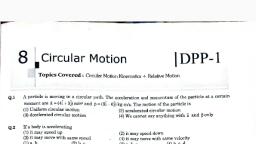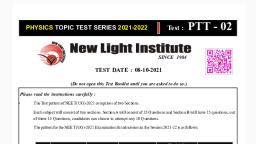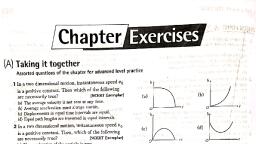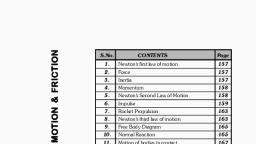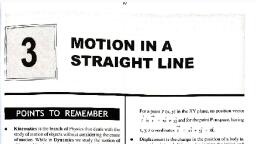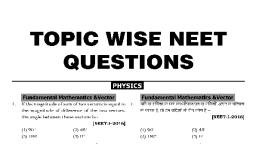Page 2 :
17, , Motion in a Plane, , CHAPTER, , 4, , 4.2, 1., , Motion in a Plane, 7., , Scalars and Vectors, , Identify the vector quantity among the following., (a) Distance, (b) Angular momentum, (c) Heat, (d) Energy, (1997), �, , 4.4, 2., , Addition and Subtraction of VectorsGraphical Method, , , , Six vectors, a through f have the magnitudes, , 4.7, 8., , and directions indicated in the figure. Which of the, following statements is true?, , (a) b + c = f, �, , (b), (c), (d), , 4.5, 3., , , d +c = f, , d +e = f, , b +e = f, , (2010), , �, , Resolution of Vectors, ^, , ^, , ^, , �, , 4., , Vector Addition-Analytical Method, , If the magnitude of sum of two vectors is equal to, the magnitude of difference of the two vectors, the, angle between these vectors is, (a) 45°, (b) 180°, (c) 0°, (d) 90°, (NEET-I 2016), , , , , The vectors A and B are such that | A + B | = | A − B | ., The angle between the two vectors is, (a) 45°, (b) 90°, (c) 60°, (d) 75°� (2006, 1996, 1991), , , , If | A + B | = | A | + | B | then angle between A and B, will be, (a) 90°, (b) 120°, (c) 0°, (d) 60°.�, (2001), �, , 5., , 6., , Motion in a Plane, , The x and y coordinates of the particle at any time, are x = 5t – 2t2 and y = 10t respectively, where x and, y are in metres and t in seconds. The acceleration of, the particle at t = 2 s is, (a) 5 m s–2, (b) –4 m s–2, –2, (c) –8 m s, (d) 0, (NEET 2017), , The position vector of a particle R as a function of, , time is given by R = 4 sin(2 πt ) ^i + 4 cos(2 πt ) ^j where, R is in meters, t is in seconds and ^i and ^j denote, unit vectors along x-and y-directions, respectively., Which one of the following statements is wrong for, the motion of particle?, (a) Magnitude of the velocity of particle is, 8 p meter/second., (b) Path of the particle is a circle of radius 4 meter., (c) Acceleration vector is along − R., v2, (d) Magnitude of acceleration vector is, , where v, R (2015), is the velocity of particle., �, , If a unit vector is represented by 0.5 i − 0.8 j + c k, then the value of c is, (a) 0.01, (b) 0.11, (c) 1, (d) 0.39, (1999), , 4.6, , , , The magnitude of vectors A, B and C are 3, 4 and, , 5 units respectively. If A + B = C , the angle between, , , A and B is, (a) p/2, (b) cos–1 (0.6), –1, (c) tan (7/5), (d) p/4.�(1988), , 9., , �, , 10. A particle is moving such that its position coordinates, (x, y) are (2 m, 3 m) at time t = 0, (6 m, 7 m) at time, t = 2 s and (13 m, 14 m) at time t = 5 s. Average, , velocity vector (vav ) from t = 0 to t = 5 s is, 7 ^ ^, 1, (a) (13 i^ + 14 ^j), (b) ( i + j), 3, 5, 11 ^ ^, ^ ^, (c) 2( i + j), (2014), (d), ( i + j) �, 5, 11. A body is moving with velocity 30 m/s towards east., After 10 seconds its velocity becomes 40 m/s towards, north. The average acceleration of the body is
Page 3 :
18, , NEET-AIPMT Chapterwise Topicwise Solutions Physics, , 4.8, , Motion in a Plane with Constant, Acceleration, , �, , 15. When an object is shot from the bottom of a long, smooth inclined plane kept at an angle 60° with, horizontal, it can travel a distance x1 along the plane., But when the inclination is decreased to 30° and the, same object is shot with the same velocity, it can travel, x2 distance. Then x1 : x2 will be, (a) 1 : 2 3, (b) 1 : 2, (c) 2 : 1, (d) 1 : 3, (NEET 2019), 16. A particle has initial velocity (2i + 3j) and, , �, , acceleration (0.3i + 0.2 j). The magnitude of velocity, after 10 seconds will be, (b) 5 2 units, (a) 9 2 units, (c) 5 units, (d) 9 units, (2012), ^, , ^, , �, , 17. A particle has initial velocity (3 i + 4 j ) and has, ^, ^, acceleration (0.4 i + 0.3 j ). Its speed after 10 s is, (a) 7 units, (b) 7 2 units, (c) 8.5 units, (d) 10 units, (2010), , �, , 18. A man is slipping on a frictionless inclined plane, and a bag falls down from the same height. Then the, velocity of both is related as, (vm = velocity of man and vB = velocity of bag), (a) vB > vm, (b) vB < vm, (c) vB = vm, (d) vB and vm can’t be related., (2000), , �, , 20. Two boys are standing at the ends A and B of a, ground where AB = a. The boy at B starts running in, a direction perpendicular to AB with velocity v1. The, boy at A starts running simultaneously with velocity, v and catches the other in a time t, where t is, a, a, (a), (b), v + v1, v2 + v 2, 1, , a, v − v1, , (d), , a2, v2 − v12, , �, , (c), , (2005), , 21. The width of river is 1 km. The velocity of boat is, 5 km/hr. The boat covered the width of river in, shortest time 15 min. Then the velocity of river, stream is, (a) 3 km/hr, (b) 4 km/hr, (c) 29 km/hr, (d) 41 km/hr, (2000, 1998), 22. A person aiming to reach exactly opposite point on, the bank of a stream is swimming with a speed of, 0.5 m/s at an angle of 120° with the direction of flow, of water. The speed of water in the stream, is, (a) 0.25 m/s, (b) 0.5 m/s, (c) 1.0 m/s, (d) 0.433 m/s, (1999), �, , 14. A bus is moving on a straight road towards north, with a uniform speed of 50 km/hour then it turns, left through 90°. If the speed remains unchanged, after turning, the increase in the velocity of bus in, the turning process is, (a) 70.7 km/hr along south-west direction, (b) zero, (c) 50 km/hr along west, (d) 70.7 km/hr along north-west direction�(1989), , 19. The speed of a swimmer in still water is, 20 m/s. The speed of river water is 10 m/s and is, flowing due east. If he is standing on the south bank, and wishes to cross the river along the shortest path,, the angle at which he should make his strokes w.r.t., north is, given by, (a) 45° west, (b) 30° west, (c) 0°, (d) 60° west, (NEET 2019), , 23. Two particles A and B are, connected by a rigid rod AB., The rod slides along perpendicular rails as shown here., The velocity of A to the, left is 10 m/s., What is the velocity of B when, angle a = 60° ?, (a) 10 m/s, (b) 9.8 m/s, (c) 5.8 m/s, (d) 17.3 m/s., , �, , 13. A particle starting from the origin (0, 0) moves in a, straight line in the (x, y) plane. Its coordinates at a, later time are ( 3 , 3). The path of the particle makes, with the x-axis an angle of, (a) 45°, (b) 60° (c) 0°, (d) 30°.�(2007), , 4.9 Relative Velocity in Two Dimensions, , �, , �, , �, , (a) 1 m/s2, (b) 7 m/s2, (c) 7 m/s2, (d) 5 m/s2, (2011), 12. A particle moves in x-y plane according to rule, x = asinwt and y = acoswt. The particle follows, (a) an elliptical path (b) a circular path, (c) a parabolic path, (d) a straight line path inclined equally to x and, y-axes, (Mains 2010), , (1998), , 24. A boat is sent across a river with a velocity of, 8 km h–1. If the resultant velocity of boat is, 10 km h–1, then velocity of river is, (a) 12.8 km h–1, (b) 6 km h–1, (c) 8 km h–1, (d) 10 km h–1, (1994, 1993)
Page 4 :
19, , Motion in a Plane, , 4.10 Projectile Motion, 25. A projectile is fired from the surface of the, earth with a velocity of 5 m s–1 and angle q, with the horizontal. Another projectile fired from, another planet with a velocity of 3 m s–1 at the same, angle follows a trajectory which is identical with the, trajectory of the projectile fired from the earth. The, value of the acceleration due to gravity on the planet, is (in m s–2) is (Given g = 9.8 m s–2), (a) 3.5, (b) 5.9, (c) 16.3, (d) 110.8 (2014), �, , 26. The velocity of a projectile at the initial point A is, ^, , ^, , (2 i + 3 j) m/s. Its velocity (in m/s) at point B is, ^, , ^, , ^, , ^, , (a) 2 i − 3 j, , (c) −2 i^ − 3 ^j, (NEET 2013), (d) −2 i^ + 3 ^j �, 27. The horizontal range and the maximum height of a, projectile are equal. The angle of projection of the, projectile is, (a) θ = tan , 4, (c) q = tan–1(2), , (b) 1 : 1, (d) 1 : 2., , (2006), , �, , 33. A particle A is dropped from a height and another, particle B is projected in horizontal direction with, speed of 5 m/s from the same height then correct, statement is, (a) particle A will reach at ground first with respect, to particle B, (b) particle B will reach at ground first with respect, to particle A, (c) both particles will reach at ground, simultaneously, (d) both particles will reach at ground with same, speed., (2002), �, , (b) 2 i + 3 j, , −1 1 , , (a) 2 : 1, (c) 2 : 3, , (b) q = tan (4), –1, , (d) q = 45°, , (2012), , �, , 28. A missile is fired for maximum range with an initial, velocity of 20 m/s. If g = 10 m/s2, the range of the, missile is, (a) 40 m, (b) 50 m, (c) 60 m, (d) 20 m, (2011), �, , 29. A projectile is fired at an angle of 45° with the, horizontal. Elevation angle of the projectile at its, highest point as seen from the point of projection, is, (a) 45°, (b) 60°, 1, −1 3 , (c) tan−1 , (d) tan (Mains 2011), 2 , 2, �, , 30. The speed of a projectile at its maximum height is, half of its initial speed. The angle of projection is, (a) 60°, (b) 15°, (c) 30°, (d) 45°, (Mains 2010), �, , 31. A particle of mass m is projected with velocity v, making an angle of 45° with the horizontal. When, the particle lands on the level ground the magnitude, of the change in its momentum will be, (a) mv 2, (b) zero, (c) 2mv, (d) mv / 2, (2008), �, , 32. For angles of projection of a projectile at angle, (45°– q) and (45° + q), the horizontal range described, by the projectile are in the ratio of, , 34. Two projectiles of same mass and with same, velocity are thrown at an angle 60° and 30° with the, horizontal, then which will remain same, (a) time of flight, (b) range of projectile, (c) maximum height acquired, (d) all of them., (2000), �, , 35. If a body A of mass M is thrown with velocity v at an, angle of 30º to the horizontal and another body B of, the same mass is thrown with the same speed at an, angle of 60° to the horizontal, the ratio of horizontal, range of A to B will be, (a) 1 : 3, (b) 1 : 1, (c) 1 : 3, (d) 3 : 1., (1992, 1990), �, , 36. The maximum range of a gun of horizontal terrain is, 16 km. If g = 10 m s–2, then muzzle velocity of a shell, must be, (a) 160 m s–1, (b) 200 2 m s−1, –1, (c) 400 m s, (d) 800 m s–1, (1990), �, , 4.11, , Uniform Circular Motion, , 37. Two particles A and B are moving in uniform circular, motion in concentric circles of radii rA and rB with, speed vA and vB respectively. Their time period of, rotation is the same. The ratio of angular speed of A, to that of B will be, (a) 1 : 1, (b) rA : rB, (c) vA : vB, (d) rB : rA, (NEET 2019), �, , 38. A particle starting from rest, moves in a circle of, radius ‘r’. It attains a velocity of V0 m/s in the nth, round. Its angular acceleration will be, V0, V, (a) 0 rad/s2, (b), rad/s2, n, 2πnr 2, V02, V02, 2, rad/s2, rad/s, (c), (d), 4πnr, 4πnr 2, (Odisha NEET 2019), �
Page 5 :
20, , NEET-AIPMT Chapterwise Topicwise Solutions Physics, , �, , (2003), , �, , 43. Two particles having mass M and m are moving in, a circular path having radius R and r. If their time, period are same then the ratio of angular velocity, will be, r, R, R, (a), (b), (c) 1, (d), (2001), r, R, r, , �, , 44. Two racing cars of masses m1 and m2 are moving in, circles of radii r1 and r2 respectively. Their speeds are, such that each makes a complete circle in the same, time t. The ratio of the angular speeds of the first to, the second car is, (a) r1 : r2, (b) m1 : m2, (c) 1 : 1, (d) m1 m2 : r1 r2, (1999), 45. A body is whirled in a horizontal circle of radius, 20 cm. It has an angular velocity of 10 rad/s. What is, its linear velocity at any point on circular path ?, (a) 20 m/s, (b) 2 m/s, (c) 10 m/s, (d) 2 m/s, (1996), 46. The angular speed of a flywheel, 120 revolutions/minute is, (a) 4p rad/s, (b) 4p2 rad/s, (c) p rad/s, (d) 2p rad/s, , making, (1995), , �, , 41. A stone tied to the end of a string of 1 m long is, whirled in a horizontal circle with a constant speed., If the stone makes 22 revolutions in 44 seconds,, what is the magnitude and direction of acceleration, of the stone?, (a) p2 m s–2 and direction along the radius towards, the centre, (b) p2 m s–2 and direction along the radius away, from the centre, (c) p2 m s–2 and direction along the tangent to the, circle, (d) p2/4 m s–2 and direction along the radius towards, the centre., (2005), , (b) 640p m/s2, (d) 40p m/s2, , �, , �, , 40. A particle moves in a circle of radius 5 cm with, constant speed and time period 0.2p s. The, acceleration of the particle is, (a) 15 m/s2, (b) 25 m/s2, 2, (c) 36 m/s, (d) 5 m/s2, (2011), , (a) 40 m/s2, (c) 160p m/s2, , �, , �, , 39. In the given figure, a = 15 m s–2, represents the total acceleration of, a particle moving in the clockwise, direction in a circle of radius, R = 2.5 m at a given instant of, time. The speed of the particle is, (a) 4.5 m s–1, (b) 5.0 m s–1, –1, (c) 5.7 m s, (d) 6.2 m s–1 (NEET-II 2016), , 47. An electric fan has blades of length 30 cm measured, from the axis of rotation. If the fan is rotating at, 120 rpm, the acceleration of a point on the tip of the, blade is, (a) 1600 m s–2, (b) 47.4 m s–2, –2, (c) 23.7 m s, (d) 50.55 m s–2, (1990), �, , 20 , 42. A particle moves along a circle of radius m, π, with constant tangential acceleration. If the velocity, of the particle is 80 m/s at the end of the second, revolution after motion has begun, the tangential, acceleration is, , ANSWER KEY, , 1., 11., 21., 31., 41., , (b), (d), (a), (a), (a), , 2., 12., 22., 32., 42., , (c), (b), (a), (b), (a), , 3., 13., 23., 33., 43., , (b), (b), (d), (c), (c), , 4., 14., 24., 34., 44., , (d), (a), (b), (b), (c), , 5., 15., 25., 35., 45., , (b), (d), (a), (b), (d), , 6., 16., 26., 36., 46., , 7., 17., 27., 37., 47., , (c), (b), (a), (c), (a), , (a), (b), (b), (a), (b), , 8., 18., 28., 38., , (b), (c), (a), (c), , 9., 19., 29., 39., , (a), (b), (c), (c), , Hints & Explanations, 1. (b) : Since the angular momentum has both, magnitude and direction, it is a vector quantity., 2., , (c) :, , � � �, From figure, d + e = f, , 3., , (b) : For a unit vector n^, | n^ | = 1, ^, , ^, , ^, , 2, , 0.5 i − 0.8 j + c k = 12 ⇒ 0.25 + 0.64 + c2 = 1, or c = 0.11, , 10., 20., 30., 40., , (d), (d), (a), (d)


